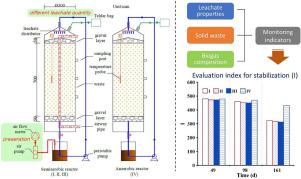Environmental Technology & Innovation ( IF 6.7 ) Pub Date : 2021-01-04 , DOI: 10.1016/j.eti.2021.101353 Junwei Ma , Yijia Li , Yuqian Li

|
Although sanitary landfilling currently effectively treats municipal solid waste (MSW) semi-aerobic bioreactor landfills (SABLs) are designed to accelerate biological processes and shorten the landfill stabilization phase. In this study, the effects of SABLs with the joint treatment of leachate recirculation and preaeration on landfill stabilization were determined by four landfill reactors, one anaerobically as a control, and three semi-aerobically with different leachate recirculation treatments (reactor I, II and III: 300 mL leachate, 600 mL leachate, and 600 mL aerated leachate per week, respectively). Results showed that reactor III had the highest removal rates of chemical oxygen demand (COD) and ammonia-nitrogen (NH-N), reaching 97% and 88%, respectively. Degradation of the organic substances could be described using an exponential attenuation model; the rates of COD, NH-N and biochemical oxygen demand (BOD5) in the SABLs increased from 0.019, 0.018, and 0.035 to 0.029, 0.025, and 0.053 day−1, respectively, when leachate recirculation quantity was increased and preaeration was applied. Finally, classification index evaluation revealed that reactor III had the lowest I value of 312, indicating that the combination of increasing leachate recirculation quantity and preaeration could positively affect the MSW stabilization phase. This finding provides experimental evidence for improving landfill management for accelerating MSW stabilization in SABLs.
中文翻译:

渗滤液再循环量和曝气对半好氧垃圾填埋场渗滤液质量和城市固体废物稳定的影响
尽管卫生垃圾填埋场目前可以有效地处理市政固体废物(MSW),但半好氧生物反应器垃圾填埋场(SABLs)旨在加快生物过程并缩短垃圾填埋场稳定阶段。在这项研究中,SABLs与渗滤液再循环和预曝气联合处理对垃圾填埋场稳定的影响由四个垃圾填埋反应堆确定,一个厌氧反应堆作为对照,三个半厌氧反应堆采用不同的渗滤液循环处理(反应器I,II和III) :分别每周300 mL渗滤液,600 mL渗滤液和600 mL充气渗滤液)。结果表明,反应器III具有最高的化学需氧量(COD)和氨氮(NH-N),分别达到97%和88%。可以使用指数衰减模型描述有机物的降解。化学需氧量,NH当增加渗滤液再循环量并进行预曝气时,SABLs中的-N和生化需氧量(BOD 5)分别从0.019、0.018和0.035增加到0.029、0.025和0.053天-1。最后,分类指数评估表明,反应堆III的I值最低,为312,表明沥出液再循环量的增加和预曝气的结合可对MSW稳定阶段产生积极影响。这一发现为改善垃圾掩埋管理以加速SABL中MSW的稳定提供了实验证据。











































 京公网安备 11010802027423号
京公网安备 11010802027423号